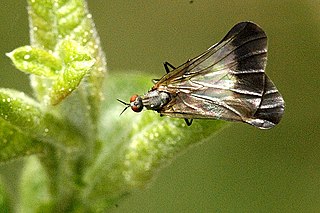
Hybotidae, the typical dance flies, are a family of true flies. They belong to the superfamily Empidoidea and were formerly included in the Empididae as a subfamily.

Silvius is a genus of flies in the family Tabanidae.

Tachydromia is a genus of hybotid flies. It is widespread around the world, with species found essentially everywhere except the polar regions and some remote islands. They are not very diverse in East and Southeast Asia, or in Africa

Rhagio is a worldwide genus of predatory snipe flies. Several species in this genus are referred to as downlooker or down-looker flies because they sometimes perch on tree trunks in a head-down position. There are approximately 170 species. They can be distinguished from other rhagionids by the open anal cell on the wings and the lack of a kidney-shaped arista.

Peleteria is a widespread genus of flies in the family Tachinidae.

Rhamphomyia is a genus of dance flies, in the fly family Empididae. It contains more than 600 species in 8 subgenera.

Tachydromiinae is a subfamily of hybotid flies widespread in the world.

Ocydromiinae is a subfamily of hybotid flies.

Hybos is a genus of hybotid flies.

Hemerodromiinae are a worldwide group of predatory flies with raptorial forelegs.

Atherix is a genus of 'ibis flies' belonging to the family Athericidae, a small family very similar to the Rhagionidae. Species within this genus are present in most of Europe and also in the Nearctic realm.

Chelipoda is a genus of flies in the family Empididae.
Chelifera is a genus of flies in the family Empididae.

Bicellaria is a genus of flies in the family Hybotidae.

Drapetis is a genus of flies in the family Hybotidae.

Oedalea is a genus of flies in the family Hybotidae.

Crossopalpus is a genus of flies in the family Hybotidae.
Micrempis is a genus of flies in the family Hybotidae.
















